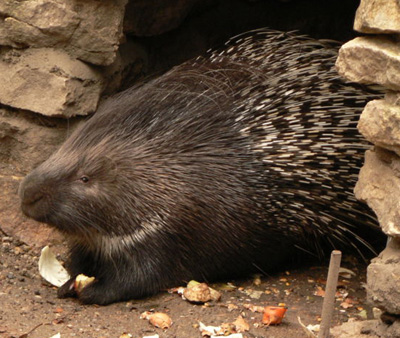

The dominant males are the ones who succeed in defending females from their rivals. These males compete with each other to determine dominance. Successful males defend a female from 1 to 4 days so that other males can't mate with her. Successful males mate with many different females, but unsuccessful males don't mate at all. The mating system of porcupines is considered female defense polygyny.

Hemlocks are also sturdy trees with high nutritional value. Hemlocks are preferred because they have very thick foliage, which helps the porcupine to stay hidden. In eastern habitats, hemlock trees are often chosen for both resting and feeding. Porcupines usually choose different trees for feeding and for resting. When ground dens are not available, porcupines will choose trees as their resting positions. Porcupines prefer to spend their winter rest time in in rock dens on the ground.

Because most predators of porcupines live on the ground, porcupines also spend a lot of time in trees where predator populations are large. When ground cover is scarce, porcupines spend more time in trees. The amount of time porcupines spend on the ground depends on how much groundcover there is for foraging and for protection from predators. In Massachusetts, they are found to spend 13% of their time on the ground. In New York, porcupines are found mostly in trees. In the Pacific Northwest, they spend most of their time on the ground. Porcupines live in open tundra, deciduous forest, and desert chaparral. Because they are found throughout the continent of North America, porcupines can be found in many different climates, and at many elevations. ( Griesemer, et al., 1998 Ilse and Hellgren, 2001 Roze, 1989 Sweitzer, et al., 1997) Porupines in the forests of New York and Massachusetts, in the Great Basin Desert, and in the woodlands of Texas have been well studied. They are found throughout most of Alaska and Canada, in the northern part of the Great Lakes region, as well as throughout the west and northeast regions of the United States. North American porcupines, Erethizon dorsatum, have the northern most range of all porcupines. Average basal metabolic rate 13.675 W AnAge.Because of this, they have more offspring than smaller males do. This is because bigger males are able to have more mates. No other porcupines are able to tolerate such cold temperatures. North American porcupines are special among their close relatives, because they are able to withstand cold. This frees their forelimbs for use in eating. Because they are so good at gripping trees, porcupines can even stay in trees using only their hind feet to hold on. Along with their keen sense of touch, this special texture on the hands and feet improves a porcupine's grip. The palms and soles of porcupines have a pebbly surface and no fur. These claws help them climb on both large tree trunks and surprisingly small branches. ( Vaughn, et al., 2000)Īll porcupines have long claws. They also have a special arrangment of their jaw muscles which helps them to chew more efficiently. This allows an animal to draw in its lips while gnawing. Porcupines have special adaptations to help them chew. Each porcupine has approximately 30,000 quills. They have microscopic barbs on the tip which help them stick into a porcupine's enemies. Quills are usually 75 mm long and 2 mm wide. This white on black marking pattern warns even color-blind predators that porcupines are dangerous. Many of their quills are fringed with white, which makes them stand out against the dark fur underneath. Spines called quills are found on the backs of porcupines from the head to the tail. They usually appear dark brown to black, although some of the hairs and spines on the backs of these animals are yellow. Porcupines have a stout, slow, lumbering form and a spiny coat. They weigh between 5 and 14 kg, and are 600 to 900 mm long. North American porcupines are the second largest rodent in North America.


 0 kommentar(er)
0 kommentar(er)
